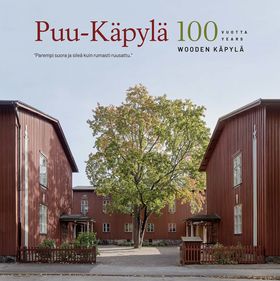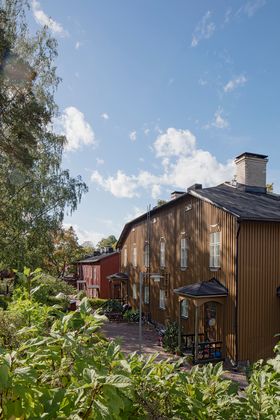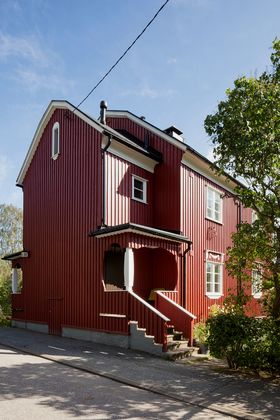Wooden Käpylä is an example of resource-wise wood construction
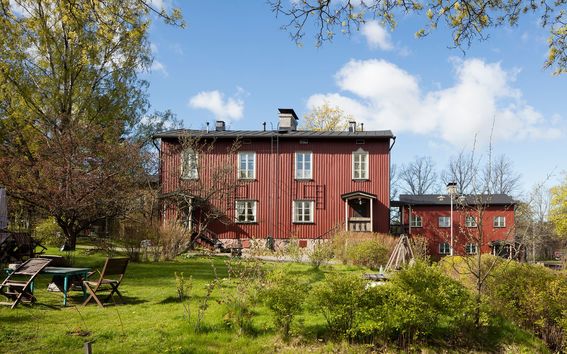
Construction of Wooden Käpylä (Puu-Käpylä) began in 1920. The houses designed by architect Martti Välikangas were built with scarce resources after the war. According to Pekka Heikkinen, an architect and professor of wood architecture, we could still learn from them today.
’Wooden Käpylä is one of the gems of Finnish wooden architecture. It was also the pinnacle of classicist architecture of its era. There is a lot to learn from history and this is a good example of that’, he says. Heikkinen has been teaching wood architecture at Aalto University for more than ten years.
The book Wooden Käpylä 100 years – ‘Shunning the ornate for the plain and simple’ looks at the area and wood construction from several perspectives, with experts sheding light on various topics. The main focus is in architecture and buildings, but also landscape, courtyards and gardens are covered. The book has been edited by Pekka Heikkinen, Professor Emerita Aino Niskanen, photographer Jussi Tiainen and the editor-in-chief of Käpylä magazine Eija Tuomela-Lehti.
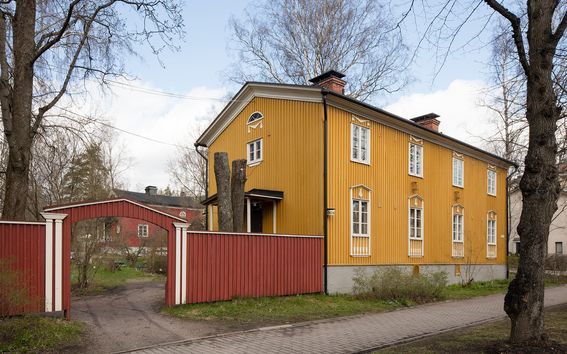
The power of industrial wood construction
Pekka Heikkinen's field in the book was to study the construction of the area. Although he has been familiar with Wooden Käpylä since his studies, getting deeper in the subject opened up many new and interesting viewpoints to the area. He says Wooden Käpylä offers new insights for everyone, including professionals.
At the time, Wooden Käpylä was a determined part of the development of industrial wood construction in Finland. Construction was done on an industrial scale and with modern tools. The project was large: about FIM 300,000 was invested in the factory. A well-equipped sawmill center was quickly completed in the middle of the area, where all parts were manufactured.
The construction project, which began in April 1920, progressed rapidly and the first inhabitants moved in as early as November.
Compared to the quality and the age of a hundred years, the houses were made extremely cheaply: a room of 15–20 square meters was made, converted into modern euros, at the price of about two square meters, which is up to ten times cheaper. The estimated age of the houses varied between 20 and 40 years, but their architectural quality is of classic level.
Wooden Käpylä was also the first implementation of a garden city in Finland, greatly influenced by England and Germany, among others. The area was a pioneer when the latest trends in the garden city were brought to Finland in the 1920s.
From under the threat of demolition to new prosperity
At the end of the 1960s, Wooden Käpylä was to be demolished, but eventually, it became an exemplary area for building protection. How did this happen?
After more than four decades, the area was badly in the need of repair. The houses were allowed to decay until the late 1960s and were in poor condition. The whole area had lagged behind time: water was still fetched from the communal sauna and the multi-hole toilets were located in the middle of the blocks.
The plan of the city of Helsinki was to demolish the houses and an architectural competition was organized for the new plan.
However, the protection decision won.
Fortunately, the area came under the Protection Act in the 1970s, which was completely new in Finland – as was the whole discussion about protecting the housing area for workers.
Wooden Käpylä has always been seen as a strong residential area for the working population, but Heikkinen points out that the area has been more diverse than initially assumed. When diving deeper in history it was learned that there were equally other groups of the population living there as well, also people with education.
Architect Pekka HeikkinenThis is how we should build now, too: use what is intact, not tear and build something new.”
Suggestion by students was a turning point
Heikkinen believes that the decision turned for the protection largely as a result of a heated public debate. ‘The value of the area was understood. It was also possible to justify that a sensible, reasonable investment in the area will lead to renovated modern housing.’
A group of students at the Helsinki University of Technology, led by Professor Bengt Lundsten, took stock of the area when it was repaired in the 1960s. ‘The students' proposal for implementing the renovation was quite a 'light version', but it managed to turn the thinking around: housing can be made this way’, says Pekka Heikkinen.
Today, Wooden Käpylä is almost in its original form and size.
According to Heikkinen, the area has been built and repaired with the same philosophy: do only what is needed, nothing in vain. In the first renovation phase, the bathrooms and toilets were made and the kitchens were renovated. All damage was repaired on a soft basis, meaning taking the damaged board off and putting a new one in place, not tearing.
He emphasizes resource wisdom.
Environmental concerns boost wood construction
According to architect Heikkinen, much more should be invested in teaching and research in wood construction. ‘Also students today demand environmental awareness in construction, and that needs to be addressed. For example, low-carbon goals are challenges that support our aims.’
In Finland, the average lifespan of buildings is about 40 and the general target 50 years, but this is not usually achieved. ‘We should be careful with the old buildings, because 70 percent of the country's wealth is attached to the building stock’, says Heikkinen.
The future of wood construction Pekka Heikkinen sees finally bright. According to Heikkinen, the state of wooden architecture in Finland is at a good level and there is a lot of potential that has not yet been used. The trend is also growing strongly globally. The key drivers of change are the rise of the environmental impact of buildings and climate issues.
‘Determined measures have been taken since the early 1990s, but now, for the first time, it feels like the industry is really on the rise. However, diversity requires greater investment and the definition of common goals.’
He welcomes the new investment in wood construction by the City of Helsinki, as well as the goals recently outlined by the Ministry of the Environment, such as a stronger link between construction and environmental impact and a comprehensive assessment of sustainability. Heikkinen considers the government's recent guidelines for wood construction to be realistic but tough, yet achievable goals.
‘We have to make sure that we build areas like Wooden Käpylä that last for a hundred years. Though, that will certainly stand for another hundred years.’
Heikkinen, P., Niskanen, A., Tiainen, J. & Tuomela-Lehti, E. (eds.) 2020. Wooden Käpylä 100 years - “Shunning the ornate for the plain and simple”, Parus Verus, Helsinki. The book has been made in collaboration with Aalto University..
Lisätietoa:
Read more news

Research Council of Finland establishes a Center of Excellence in Quantum Materials
The Centre, called QMAT, creates new materials to power the quantum technology of coming decades.
Two Unite! Seed Fund projects involving Aalto secure top EU funding
Two prestigious EU grants have been awarded to projects that were initially supported with Unite! Seed Funding. Both projects involve Aalto.
Major funding powers development of next-generation machine technology aimed at productivity leap in export sectors
The BEST research project is developing new types of sealing, bearing, and damping technology.







